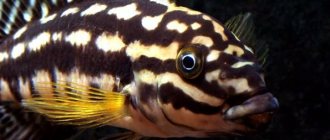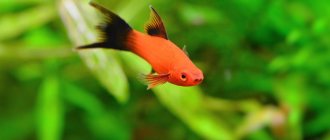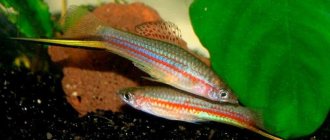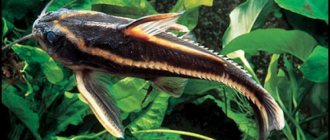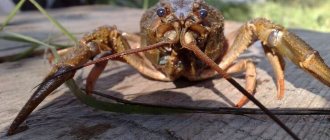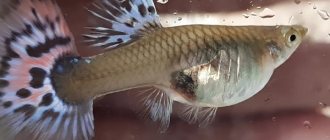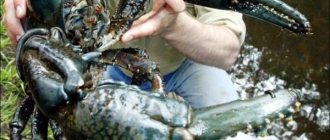External characteristics
The body of the fish is slightly elongated and flattened laterally, and the tail fin consists of two blades. The dorsal fin is shorter than the anal fin.
The neon back is a dark green shade with a lighter color on the belly. Along the body of the fish there is a dark stripe with a luminous turquoise undertone. The stripe narrows as it approaches the caudal fin.
The neon's tail is a mixture of red brick and green, and the anal fin has a thin, uneven stripe. Males are much slimmer and smaller than females.
If you keep the fish in suitable conditions, they live up to 5 years and grow up to 3.5 cm in length.
Green neons are small and very active, they are easy to breed, and they are not demanding in terms of housing conditions and food. But you should not purchase breeding forms.
TOP 20 popular types of guppies
The most beautiful and most popular varieties of guppies are shown in the table.
| Breed name | Description |
| Albino | The pigment is completely absent in the color of the fish, the whole body and fins are pure white, and the eyes are painted bright scarlet. |
| Berlin guppy | At the head, the body is a silvery natural color, from half the blue-orange pearlescent hue begins to thicken, acquiring the greatest saturation at the tail, which, like the dorsal fin, is of solid red or orange shades. |
| Berlin gold | Almost the same color as the Prussian guppy, but half of the body is almost black with red spots. |
| Blond | The whole fish, including the plumage, is an even snow-white color, as if it had been dipped into a can of oil paint. Eyes with an orange tint. |
| Yellow blond | The eyes of this species are almost black, and the color is completely soft yellow tones with a white tint. |
| Red blond | This is the half closest to the head with dark eyes, blond. And the back part is bright, rich scarlet shades, including all the plumage. |
| Savage | A very small species of gray natural with modest plumage, but unexpectedly bright, rare spots are scattered throughout the body - black (reminiscent of eyes), scarlet, green. |
| Multicolor | There is almost no gray in color, the whole body shimmers in different colors, and the lush plumage when opened resembles a fancifully colored fan. |
| Panda | Almost bicolor color. The entire body and small round fins are densely black, and the area near the head and the skull itself are silvery, light gray. |
| Emerald | Otherwise called the emerald species. The entire large body shimmers in light green, turquoise, malachite tones with fancy blue flashes on the edges of the plumage and on the back. |
| Glass | The main color is almost transparent gray, with azure bright spots scattered throughout it, denser towards the tail, and sometimes there are greenish shades. The plumage is also spotted and voluminous. |
| Tuxedo | The anterior half of the body is white, light gray, almost transparent. And the back part is blue, more saturated towards the tail. The plumage is often red in color. |
| Japanese blond | The body is bright white with dark eyes. Closer to the tail, soft blue tints appear. The same tail, often lyre-shaped, large. |
| Orange filigree | The whole body is dark in color with frequent small yellow or orange specks. The same bright volumetric plumage has a red edging, and the head is silver. |
| Red clove | The entire fish is completely painted red, including the head and plumage. She is usually of the skirt type. |
| Sunset | The name of this breed translates as “sunset”. The body is silver with a reddish tint, and the voluminous plumage is scarlet. |
| Martin | The elongated body, shimmering pink, ends in plumage that resembles the multiplied tail of a swallow. Its rays end in highly elongated branches of red tones. |
| Galaxy | A very colorful fish with a mosaic coloring, through which the silver background shines through. |
| Carpet | There are different colors - yellow, red, blue, green. The body is monochromatic, the background becomes thicker towards the tail. And all the volumetric plumage is mosaic in color. |
Feeding
Green neon guppies are omnivorous fish, so their diet should contain protein and plant foods . When breeding at home, carefully processed special food products can be given as food, for example, special granules and flakes, frozen or live food - daphnia, bloodworms, tubifex. It is also permissible to give fresh, finely chopped vegetables - spinach, lettuce. A variety of green guppy is considered to be the blue neon guppy .
It is recommended to feed the fish twice a day in small portions. This is better than giving food once a day, but in large quantities. The fry eat more often as they need nutrition to grow. They have a small stomach and metabolism occurs at a high speed - which means that fractional meals are the optimal solution for them.
Diseases
Guppy fish suffer from the same diseases that affect tropical fish. Therefore, the stamina of goosebumps does not always save. Sometimes a severe infection occurs or the fish is injured. Treating aquarium inhabitants is a complex matter.
Sick people are often destroyed, after which the aquarium must be disinfected, and proper care must not be forgotten
Tail destruction
The condition of the tail can be spoiled by:
- fin rot, which destroys the interray tissue, is more dangerous for scarf guppies;
- red scab, marked by a bright red coating that affects the tip of the tail, then slowly destroys the entire caudal fin, more often appears in males;
- splitting, when the fin splits longitudinally, threatens veiled males.
Hump formation
If the fish are old, curvature is normal; the appearance of a hump in fertile guppies is a disease caused by:
- injury;
- scoliosis;
- sudden changes in the volume of the holding tank, overcrowding;
- overfeeding;
- the appearance of tuberculosis.
Oxygen starvation
The state of hypoxia is considered fatal for fish.
Symptoms: Breathing rapidly or with difficulty, hovering or swimming close to the surface with the mouth open, noticeably swollen gills and lack of coordination. In severe cases, the fish lie on the bottom. The color sometimes becomes brighter, the fish's eyes become glassy and do not move.
Inactivity
If the guppy begins to move little and does not want to eat food, the body becomes covered with a mucous coating, which tightens the gill slits and sticks the fins together - this is a manifestation of costosis. In addition, it is difficult for the fish to breathe, and the body becomes covered with bluish spots.
How to keep
This type of aquarium fish is very active. Neon guppies are peaceful, they get along well with other individuals from their family. But the green forms are too shy, so it is recommended to keep them in a small flock of 5 – 10 individuals. When swimming in a school, they feel more confident and stand out among other fish with their colors. You should not put them in the same aquarium with fish that are too large, as the latter can simply eat miniature guppies.
Most often, guppies are found in the middle layers of water, and you need to choose the volume of the aquarium based on 15 - 20 liters of water per pair. The soil and wall should be dark shades, and plants, regular and floating, can be planted along the back wall. In addition, grottoes and driftwood will look good as decoration.
Neon green guppies, like blue neon guppies, are sensitive fish and do not respond well to deteriorating water quality. The most suitable temperature for them is from 22 to 26 degrees, the filter can be peat, and every week you will additionally need to change 25% of the water volume in the aquarium.
Varieties of guppies by fin and tail type
This is how guppies are classified all over the world. This division appeared in the early 2000s and includes 13 species. The fins of different types of guppies have large differences.
Fantails
The tail is voluminous and without points. The shape is similar to a triangle or an open fan. The dorsal fin is erect, the end reaches a third of the length of the tail.
Spinetails
Representatives of this species have a round tail, in the center of which protrudes a long ray, similar to a sharp needle. The dorsal fin is long and has a pronounced upward slope.
Double sword
The fin is oval, has elongated parts along the edges. Ideally, the length of the fin is equal to the length of the body or 6/10 of this length. The fin, which is located on the back, has a narrow shape and reaches the end of the first third of the tail.
Upper sword
The name speaks for itself. The upper fin has a sharp sword-like shape. Forms an angle of 15 degrees with the axis of the fish’s body. The caudal fin is oval and should be equal to the length of the body. The oval part of the tail should not be more than 4/10 of the length of the body.
The sword of the caudal fin is sharp, straight, and the dorsal fin has the same characteristics as the caudal fin, but rises sharply from the base. It is also narrow, sharp and straight.
Lower sword
The surface of the caudal fin has a rounded shape. The lower rays extend from it and are very similar in shape to swords. The length of the caudal fin is from 6/10 to 9/10 of the body length. In relation to the axis of the body, the “sword” forms an angle of at least 15°. The dorsal fin is narrow with a pointed end.
Flagtails
The “fan” of fish has smooth edges without protrusions. The tail looks like a flag. It looks like a rectangle with rounded corners. The dorsal fin is clearly raised up, has narrow sharp ends, and reaches the middle of the tail in length.
Spadetails
The shape of the rear fin resembles a square with a slight point towards the center. The top and bottom of the fin are parallel. The caudal fin is 1/2 the length of the body, the height (width) is 8/10 the length of the caudal fin.
The dorsal fin rises steeply at the base. It is straight, with a sharp end reaching the end of the first third of the caudal fin.
Veiled tails
Veiled guppies are distinguished by the fact that the tail part of their body looks like a skirt or fan. The tail is concave at the back, the top and bottom are rounded. The fin on the back “stands”. It is narrow and also rounded at the end.
Triangel
Guppies have a triangular tail with distinct edges. It looks like an open fan. The dorsal fin is wide and rises sharply.
Lyrebirds
The caudal fin is similar in shape to a lyre. The lower and upper rays are curved, slightly pointed. The dorsal fin rises upward, its end reaching the first third of the caudal fin.
Fork
Fork guppies have a tail that bifurcates, resembling the tines of a fork. The fin on the back is curved, has a sharp end, which reaches the third part of the tail.
Speartails
The tail of these guppies is impressive in size. It is almost equal to the length of the body. The rear fin is spear-shaped.
Round-tailed
The tail part of the fish's body is slightly rounded. The tail is small. The length of the fin reaches half the total size of the entire fish. The dorsal fin is rounded, raised and extends to the caudal fin.
Maintaining the purity of the breed
If there are several breeds in the aquarium, to maintain the purity of the breed, you need to carefully monitor the males and females.
In growing offspring, it is necessary to place the mature males in a separate aquarium.
As soon as males grow up, they pay the most attention to females. Often several males “hunt” one guppy
Otherwise, they may have time to fertilize the females and the purity of the breed may be compromised. If this happens, then the shape and color characteristic of this species are not preserved.
On the other hand, if the goal is to develop new shapes and colors, it is necessary to act differently. Breeders use various methods to obtain new breeds.
But often they take three pairs, which are kept in different containers. Separately, it will also be necessary to maintain their offspring, among whom the best representatives will be selected for crossing.
Important! Breeders separate guppies by sex and place them in different aquariums. For breeding, one best male and female are selected and placed in a separate small aquarium for several weeks.
The sex of individuals is determined at the age of one month. If the water temperature is higher than normal, then ripening occurs faster.
The female becomes noticeable by the presence of a birth spot (a darkened area near the anal fin). The male is brighter in color and is also distinguished by the formation of a gonopodium.
Experienced breeders, in order to avoid unnecessary spawning and to give the females some rest during the winter, recommend maintaining the water temperature at 18°C.
Habitat
Initially, these fish lived in freshwater bodies of Brazil, Venezuela and Guiana. Gradually, they began to be artificially populated in other rivers and lakes.
This was done to reduce the population of malaria mosquitoes. As it turns out, guppy fish happily eat their larvae.
Guppies in nature are completely different from the inhabitants of home aquariums. Males and females are smaller in size, and the coloring is not as luxurious
Important! Aquarium guppies bred in artificial conditions differ significantly from their natural appearance. The difference is not only in color, but also in the huge variety of tail shapes.
Today, acclimatized guppies even live in the Moscow River, reservoirs of Yaroslavl, Nizhny Novgorod, Tver and Rybinsk.
Nutrition
The most favorite food of these aquarium fish is bloodworms. Although in fact, fish are absolutely omnivorous.
On average, one adult male eats from 10 to 20 pieces per day. small bloodworm. The female should receive at least 3-5 larvae.
In addition to this type of food, you can feed plankton, asplancha, annelids, lower plants, and growths on algae.
It is best not to give the entire amount of food at once, but to divide the food into several doses.
The first meal should take place no earlier than half an hour after the lights are turned on, and the last meal should take place no later than an hour before the lights turn off.
Approximately how much do they cost?
They buy guppy fish in pet stores or markets, where they offer a large selection of breeds. When buying, it is worth remembering that if you take 2 males, then you will need to take 4 females. The cost is influenced by the popularity and rarity of the breed, as well as the age and size of the specimens. The average price of a guppy is 90-110 rubles.
A fascinating sight - bright and colorful small fish with fluttering tails and fins scurrying around in the aquarium. Dear readers who want to have such beauty at home, please note that you should start with guppies. Care is clear and uncomplicated.
And what happens, we hope that you will send comments.
